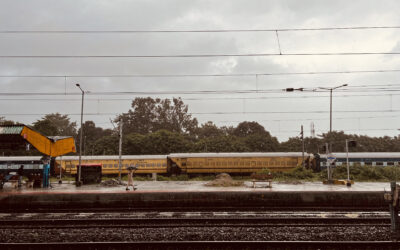“… it is in the nature of all things to decay.”
Gautama Buddha
As I stumbled upon this saying, it struck me as more real than ever before. Perhaps the mood of the day and my recent visit to Kushinagar had something to do with it. Some sort of comfort and normalcy was being built as my head was swirling with thoughts about the inevitable nature of decay. Today I’m looking back at the visit which felt okay-ish at that time. I realized that some places seem best when we revisit them inside our heads. I love to visit historic places and architecture but was not very enthusiastic about visiting Kushinagar. When I saw the pictures on the internet, I found the present-day structures and surroundings of the place less engaging than I had hoped for.
What was I really looking forward to? When I was studying its history as a part of my graduation, I had dreamt of visiting the four important places that are significant to Buddha’s life and are popular today as sites of the Buddhist circuit. Lumbini (place of birth), Bodh Gaya (place of enlightenment), Sarnath (place of first preaching) and Kushinagar (place of passing away). Here was my chance to visit one of them. So, I decided to ditch my lack of enthusiasm and go anyway!
Encounters with Mahayana Buddhism
The sculptures housed by the Chinese Temple at Kushinagar reminded me of all my encounters with Mahayana Buddhism.
After the death of Buddha, Buddhism split into two sects – Hinayana and Mahayana. The Hinayana sect believes in abstract representation of Buddha and focused on individual salvation through self-discipline and meditation. While the Mahayana sect believed in Buddha’s divinity and began with idol worship of Buddha. This led to a long tradition and flourishing of various schools of art that specialized in sculptures of Buddha and Bodhisattvas.
Buddhism reached many places across the world and heavily influenced especially the countries in East and South-East Asia. The Mahayana sect is predominant across these countries, along with the existence of other sects. As we entered the Chinese temple, at Kushinagar, I was amazed by the style of the sculpture of the deity. This is because it looked like a blend of a Chinese Warrior who had a face like that of Buddha.

It reminded me of the wide variety of variations in sculptures of Buddha I had seen in places like Nepal, Karla-Bhaje Caves, and Ellora Caves. The imagination of the sculptors and the way they blend their indigenous art form with elements borrowed from different styles has always intrigued and fascinated me.
Image of Ellora Caves, Mahrashtra, India
In the earliest times, Buddha was not depicted in the form of images and sculptures. But later, the Mahayana sect of Buddhism started portraying Buddha in the form of sculptures, which according to historians is a form of influence of Hinduism. For example, some sculptures show heavily ornamented Buddha-like Hindu deities, or Buddha in the form of a Chinese Warrior or muscular Buddha like the Greek God Apollo. It is always interesting to see how cultures localize art and depiction.
Image of Lumbini, Nepal

The ancient times (5th century B.C. and aftermath) were the times when exchanges and engagement between different cultures allowed them to heavily influence each other. And it beautifully reflects in the sculptures and architecture. Cultural syncretism, wherein, diverse cultural elements, blend in together resulting in a new harmonious expression was a characteristic feature of this time. It was flourishing with the patronage of the rulers, traders and ideas of people and became the enriching force of social, economic as well as political life of the times.
I wonder if we are losing that fluidity in today’s time, as we are increasingly building social borders. This borrowing and exchanging of styles was a multilateral, vibrant street where all cultures were interacting with each other.
Of course, the ancient texts also mention the debates between religions and cultures about who was superior to whom, but art was a place that propelled the debates towards marvelling creations! These debates were witty! Which makes me feel glad that they were happening too!
The Event Of Mahaparinibbana
The Kushinagara of historic times, that is, 5th century B.C was a bustling place. It flourished as one of the important towns in the Malla kingdom. It was strategically located at the crossroads of several trade routes, which contributed to its prosperity and cultural diversity. The Mahaparinibbana or the Great Extinguishing was an event that unfolded a different trajectory for Buddhism and the rise of the Magadha kingdom. It marks the profound moment of his passing into final liberation, signifying the end of his earthly journey and achieving ultimate enlightenment. This event holds immense significance in Buddhism as it symbolizes the transcendence of suffering and the attainment of spiritual liberation.
Recalling all this, I was standing there in the Mahaparinibbana Stupa, as I looked at the serene posture of reclined Buddha. I took walked a circle around the statue, noticing the details of the inscriptions around the statue. It felt calm and unfathomable at the same time.

Last Stop At Ramabhar Stupa
The structure of Ramabhar Stupa was our last stop. It has been constructed at the site where a part of Buddha’s ashes were placed. It marks the spot where the ancient Malla people performed his final rites. This ancient monument, also known as the Mukutbandhan Chaitya, is a place of pilgrimage as well as meditation today. People visiting from different parts of the world chant mantras here. This towering structure of exposed bricks holds an aura of tranquillity. We walked around the stupa, marvelling it’s architectural simplicity. The palm trees and sun setting in the background made us pause and immerse into the serenity. Lying down on the grass under the bare sky, watching the birds return to their homes felt peaceful.
“Sitting quietly, doing nothing, Spring comes, and the grass grows, by itself”
Matsuo Bashō, poet of the Edo period in Japan

Beyond Structures To Stories
In this modern era, we widely recognize the importance of preserving our cultural heritages. However, the focus should not solely be on conserving physical structures. It must extend to offering a comprehensive experience of the information and significance that these places hold. I was looking for the stories that Kushinagar holds, but realised that they were kept in closed books only. They could come alive in the place itself. Too little information was displayed, for a place which has such a rich history. We need a more holistic approach to heritage preservation, one that breathes life into the narratives of the past.
Living In The Land Of Buddha
Living in Bihar, the very land where Buddha once walked and preached his ideas evokes a sense of awe and humility in me. Often, while on field journeys I find myself contemplating the rich history that surrounds me, realizing that these very roads and fields were once Buddha and people were thinking. It was an era when the heterodox sects, Jainism, Buddhism, and Ajeevikas were rising in resistance to the religious orthodoxy.
The thought fills me with wonder and a desire to delve deeper into where did Buddhism disappear from this region? (modern-day Uttar Pradesh and Bihar). I am keen to explore. This visit revived my love for history. I love not just the stories of past but also what the discipline of history teaches me. It is the place where I was introduced to complexities. History is where I began to fall in love with complexity. It is what teaches me to look at things objectively. Sharing an excerpt from older writings of mine. This had come after days of being frustrated with seeing history being a victim of ideological battles:
[…]
History is not what you’d like to believe
Or what comforts you
Or what suits your narrative,
But, ‘it’s what actually happened’
And no matter how much we wish
Things could have happened differently,
Here we are!
To engage in the eternal dialogue
Of the past and the present
…
I would be happy to share more of my reflections on History in the blogs to come. Until then sharing a podcast recommendation from one of my favourite historians of today’s times,
Aniruddh Kanisetti – Echoes of India | History Podcast (anirudhkanisetti.com)




Loved reading your blog, Siddhi. It brought back so memories from this trip. It will be interesting though to find out about the fading of Buddhism and Jainism. Keep us updated.